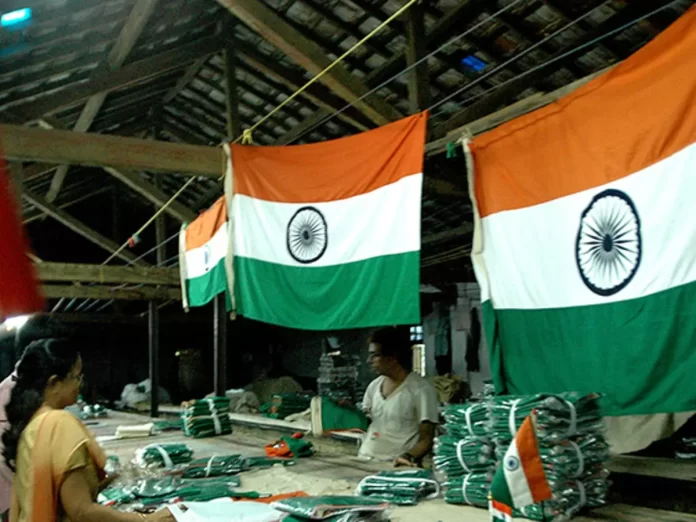Sonia Backs Khadi
Sonia Gandhi’s advocacy for khadi as the sole fabric for the Indian tricolor is a statement deeply rooted in the fabric’s historical and symbolic significance for India. Khadi, a hand-spun and hand-woven cloth, is more than just a material; it represents a rich legacy of Indian self-reliance, resistance to colonialism, and cultural pride. In this essay, we will explore Sonia Gandhi’s position on khadi and its implications for national identity, economic self-sufficiency, and cultural heritage.
Historical and Symbolic Significance of Khadi
Khadi, often associated with Mahatma Gandhi and the Indian independence movement, holds a special place in Indian history. During the British colonial era, Gandhi promoted khadi as a symbol of resistance against the exploitative practices of British textile mills. The spinning wheel, or charkha, became a potent symbol of self-reliance and national pride. By endorsing khadi, Gandhi encouraged Indians to produce their own cloth, which not only helped in economic self-sufficiency but also fostered a sense of unity and national identity.
The tricolor, India’s national flag, is a symbol of the nation’s sovereignty, unity, and diversity. Traditionally, the flag’s fabric has varied over time, including materials like silk, polyester, and nylon. However, Sonia Gandhi’s proposal to use khadi exclusively for the tricolor aims to reaffirm the flag’s symbolic ties to India’s struggle for independence and its values of self-reliance and resilience.
Sonia Gandhi’s Advocacy for Khadi
Sonia Gandhi, the former President of the Indian National Congress and a prominent political leader, has consistently championed causes related to Indian heritage and social justice. Her advocacy for khadi as the sole fabric for the tricolor is a testament to her commitment to reviving and preserving traditional Indian values. Gandhi’s position reflects her broader vision of promoting sustainable and indigenous practices while reinforcing the cultural and historical continuity of India’s national symbols.
In her speeches and public statements, Sonia Gandhi has highlighted khadi’s role in fostering economic empowerment and environmental sustainability. By endorsing khadi for the tricolor, she emphasizes the need to return to sustainable practices that honor India’s past while addressing contemporary challenges. Her stance is not just about reviving a tradition but also about reinforcing the principles of self-reliance and ecological responsibility that khadi embodies.
Economic Implications of Using Khadi
The economic impact of adopting khadi as the sole fabric for the tricolor is multifaceted. On one hand, it could provide a significant boost to the khadi industry, which has faced challenges in maintaining its relevance in a market dominated by synthetic fabrics. Khadi production supports rural artisans and small-scale weavers, creating employment opportunities and promoting economic development in underserved areas.
Promoting khadi could also stimulate interest in other traditional crafts and industries, fostering a broader movement toward sustainable and ethical consumerism. By increasing demand for khadi, the government could support initiatives that enhance the quality of the fabric, improve production techniques, and ensure fair wages for artisans. This move could also encourage more people to invest in and support local craftsmanship, contributing to a more diversified and resilient economy.
However, there are challenges to consider. The production of khadi, while environmentally friendly and sustainable, may be less cost-effective compared to mass-produced synthetic fabrics. Ensuring a consistent supply of high-quality khadi for the tricolor would require investment in infrastructure, training, and quality control. Balancing these factors with the need for economic efficiency and affordability is crucial for the successful implementation of this initiative.
Cultural and Environmental Impact
Khadi’s cultural significance extends beyond its historical context. It is a symbol of India’s rich textile heritage and artisanal traditions. By making khadi the exclusive fabric for the tricolor, Sonia Gandhi’s proposal reinforces the importance of preserving and celebrating these traditions. It encourages a sense of pride and connection to India’s cultural roots, fostering a deeper appreciation for the country’s historical journey and values.
From an environmental perspective, khadi is a more sustainable choice compared to synthetic fabrics. The production of khadi involves minimal use of chemicals and dyes, reducing its ecological footprint. By supporting khadi, the initiative aligns with broader global movements toward sustainable and eco-friendly practices. It promotes a shift away from environmentally harmful production processes and encourages more responsible consumption patterns.
Challenges and Considerations
While the proposal to use khadi exclusively for the tricolor is compelling, it is not without its challenges. One significant issue is the scalability of khadi production. Ensuring a steady and high-quality supply of khadi for the tricolor, while maintaining its traditional characteristics, requires careful planning and investment. The production capacity must be aligned with the demand, and quality control measures need to be implemented to uphold the flag’s dignity and integrity.
Additionally, there is a need to address the perception of khadi in the contemporary context. For many, khadi may seem like an outdated or niche product. Efforts to modernize the production techniques and promote khadi’s relevance in today’s market are essential for gaining widespread acceptance. This involves marketing strategies that highlight the fabric’s historical significance, sustainability, and artisanal value.
Conclusion
Sonia Gandhi’s advocacy for khadi as the sole fabric for the Indian tricolor is a powerful statement that weaves together historical legacy, cultural pride, and contemporary values. It is a call to revisit and reinforce the principles of self-reliance, sustainability, and national unity that khadi represents. While the proposal presents both opportunities and challenges, it offers a chance to reaffirm India’s commitment to its heritage and values in a meaningful and impactful way. Embracing khadi for the tricolor could serve as a symbolic and practical step towards a more self-sufficient and environmentally conscious future, reflecting the enduring spirit of India’s struggle for independence and its ongoing quest for a more sustainable and equitable society.
































